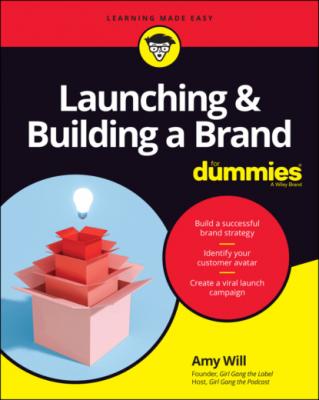Launching & Building a Brand For Dummies. Amy Will
Читать онлайн.| Название | Launching & Building a Brand For Dummies |
|---|---|
| Автор произведения | Amy Will |
| Жанр | Малый бизнес |
| Серия | |
| Издательство | Малый бизнес |
| Год выпуска | 0 |
| isbn | 9781119748052 |
Brainstorming brand names
Brainstorming is a creative activity in which you suspend critical thinking and give your right brain free rein. It’s generally a group activity involving several team members gathered in a conference room with a whiteboard and markers, calling out and jotting down ideas that pop into their heads.
I encourage you to take the same approach, alone or with others, to come up with a long list of possible brand names. Suspend your critical mind, and jot down any brand names that pop into your head or the heads of other participants. There should be no criticizing, ignoring, scoffing at, or crossing off any ideas.
Choosing the best brand name
When you have a long list of brand-name candidates, narrow it down to three to five names. At this point, you switch from right-brain (creative) mode to left-brain (critical) mode.
You can start by crossing obviously lousy names off the list, but as you cut more names, competition for the top spot stiffens. Evaluate the remaining names based on the criteria presented in the earlier section “Following brand naming parameters.”
When only a few brand name candidates remain, you can debate the merits of each in the hopes of narrowing the list further. If that approach doesn’t work, you may want to engage in another brainstorming session.
Chapter 4
Clarifying Your Branding Goals
IN THIS CHAPTER
One of the biggest mistakes people make when they start branding is that they start branding. I know that sounds odd, but my point is that most people start by creating a website or blog or podcast before they have any idea of what they’re trying to accomplish. As a result, they work too hard at it, everything they do has little or no impact, they have nothing in place to figure out why, and they begin to wonder what they’re doing wrong. What they did wrong is that they started branding when they should have started planning.
As Steven Covey, author of the best-seller The 7 Habits of Highly Effective People, advises, “Start with the end in mind.” After all, how can you hope to get where you’re going if you don’t even know where that is?
In this chapter, I encourage you and guide you through the process of starting with the end in mind by establishing branding goals and figuring out the best methods to achieve those goals. Then I proceed to explain how to put a system in place to measure success and identify what’s working and what’s not so you can make well-informed adjustments moving forward.
Identifying Your Branding Goals/Objectives
Ultimately, many people have the same branding goals: a better, richer life: more money; more free time; enjoyable, rewarding work; and delighted customers/clients. We can all dream, right? Unfortunately, “a better, richer life” doesn’t cut it as a branding goal because it’s not SMART:
Specific: The goal of “a better, richer life” is vague. Specifically, what do you want to accomplish? Increased sales? Lucrative speaking engagements? More and better clients for your consulting business? Book deals with major publishers?
Measurable: Setting a measurable, quantifiable goal provides a way to evaluate success. A better goal than “increased sales,” for example, would be “a 10 percent boost in sales over last year.”
Attainable: Aim high, but make sure you’re setting up goals along the way. Smaller goals that help you achieve your end objective are important to keep momentum going in building a brand. If you have high goals, simply make a roadmap to help get there.
Relevant: Be sure that your goal will strengthen your brand. You must have a good answer to the question “If I achieve this goal, how will it improve my brand?” Be mindful that as your brand evolves, so do your goals and your relevance.
Time-based: Specify a deadline for achieving your goal. Otherwise, procrastination is too easy.
In the following sections, I introduce five branding goals/objectives to consider and present different ways to achieve each one. These goals/objectives are just a small sample to get you pointed in the right direction and spark your creativity.
Increasing brand recognition and awareness
A top goal of all branding is to increase brand recognition and awareness. Brand recognition is the ability of consumers to identify a brand by its attributes, such as its logo or distinctive colors. You may see the familiar green-and-white mermaid logo, for example, and instantly recognize it as the Starbucks logo. Brand awareness is the extent to which consumers understand what a specific brand represents or stands for. You see the Starbucks logo and know that it represents quality coffee and a relaxing and enjoyable experience.
Brand recognition and awareness are fundamental to a brand’s success. After all, if people don’t know about your brand, it’s not much of a brand. Brand recognition and awareness can open doors to customers, opportunities, and partnerships. These factors are especially important if you’re hoping to partner with large corporations because they’ll want social proof
